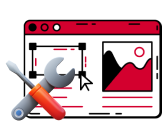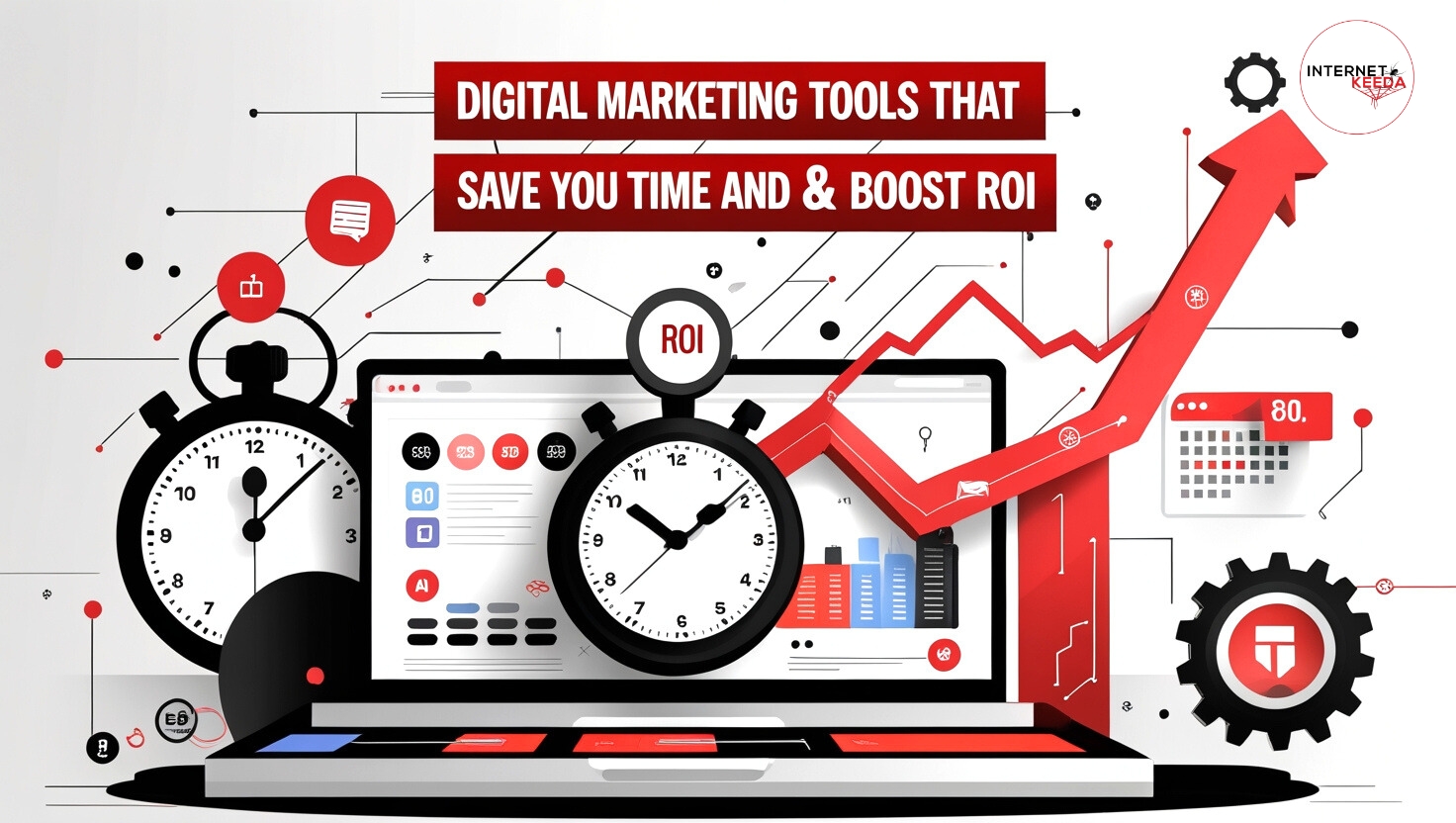When Time Feels Like It’s Slipping and Results Are Hard to Measure
Have you ever felt like you’re constantly doing “marketing stuff,” but the scoreboard never moves? You’re not alone. Whether you’re running a small agency, a bootstrapped business, or freelancing from a corner desk, that sinking feeling is common, like juggling five platforms, two newsletters, and one tired brain.
Here’s the quiet truth most blogs don’t say out loud: digital marketing is noisy. Tools shout promises of automation and ROI, but not everything that sparkles saves you time. The good ones? They don’t just help you do more. They help you do less, better.
This guide isn’t a sales pitch for platforms. Think of it like chatting with someone who’s tried a lot of these tools, failed with a few, and found a handful that genuinely make a difference. You’ll get stories, subtle suggestions, and enough space to decide what fits your rhythm, not what screams the loudest on social media.
Digital Marketing Tools That Save You Time and Boost ROI
It’s 9:42 a.m. Your coffee’s gone cold. Your to-do list keeps multiplying like it's on a mission. One tab has Google Analytics loading. Another’s open to your email platform. Your phone buzzes with a client asking if last week’s post performed. You glance at your calendar and realize you’ve got fifteen minutes to finish a proposal you haven’t even started.
And in that moment, you wonder something quietly — is this how it's supposed to feel?
Most small business owners, freelancers, and marketing professionals have been there. The tools we use were meant to help. Somewhere along the way, though, they started feeling like another inbox. Another dashboard. Another password to remember.
But buried beneath that digital fatigue, there’s a quiet shift happening.
Tools are getting smarter. Not louder, not pushier, just better at working for you instead of demanding from you. They’re less about complexity and more about clarity. And the best ones? They disappear into your day, giving you back what you’ve been craving most: time, focus, and results that feel real.
This guide is for those trying to do more with less. For those who want to grow but don’t want to burn out chasing algorithms and CTR charts. It’s not a list of software. It’s a reflection of how the right tools can reshape your workflow in ways you didn’t even know were possible.
Let’s walk through the systems that save time, the tools that make sense, and moments where it all starts to feel lighter. You might already use some of them. Others might surprise you. But every tool we cover does one thing beautifully, it creates space for what matters.
Not just more output. More ROI. More ease. More breathing room.
Let’s start with the one thing that never lies on your calendar.
When Time Gets Eaten by Tabs: The Hidden Cost of Fragmented Marketing
Ask any business owner what their day looks like, and you’ll likely get a quiet laugh followed by a sentence that starts with “It depends.”
One minute you’re tweaking a landing page headline. Next, you’re hopping into a Zoom call. Then comes a social post you forgot to schedule, a billing email you still haven’t written, and somewhere in there, you’re supposed to grow your brand.
What eats your time isn’t the big stuff. It’s the small decisions that stack up like dominoes. The time you spend switching tools. Rewriting the same email for the third time. Copy-pasting between tabs just to make something look halfway decent. You start to wonder, is this the best use of my day?
That’s where tools with real empathy step in. Not the kind that tosses more features at you, but the kind that feels like having an invisible assistant in the background, quietly stitching the chaos together.
Take something as simple as scheduling content.
When creators first discover platforms like Notion, ClickUp, or Trello, it’s rarely love at first sight. But then something clicks. You realize you’re no longer asking, “Where did I put that caption?” or “Did I already send this?” Instead, it’s all there. Organized. Predictable. And, most importantly, yours.
You’re not overwhelmed. You’re in motion.
And that’s the magic, not just saving time, but reclaiming the space between your tasks.
When Repetition Steals Your Creativity: The Quiet Power of Content Automation
There’s a moment every marketer hits the realization that they’re not doing the creative work they signed up for. Instead of ideating big-picture campaigns or writing from a place of clarity, they’re stuck inside the content hamster wheel. Drafting the same email three times. Manually uploading videos. Copying Instagram captions into scheduler after scheduler. It becomes a cycle that not only eats up your time but chips away at your energy.
But what if that loop didn’t need your attention? What if the process simply ran while you focused on the ideas that matter?
This is where content automation quietly earns its place. Not by shouting promises or boasting flashy dashboards, but by doing what it’s meant to do, free your hands from the repetitive and give you back your headspace.
Many creators today don’t even realize how much time they’re giving away. It starts small. One newsletter here. A Facebook post there. Then one day, you look up and realize entire mornings are being drained by logistics, not strategy.
Enter tools like Metricool, Buffer, and even AI assistants baked into platforms you already use. These aren’t just schedulers. They’re quiet enablers. They take the content you’ve already worked hard to create and make sure it gets where it needs to go on time, without reminding you ten times first.
There’s something incredibly calming about knowing your posts are already queued up. Your weekly email will go out, even if you forget to hit send. That a smart tool has scanned your post and optimized it for reach without turning it into something sterile.
It’s not about losing control. It’s about letting go of the parts that don’t need your touch.
Clarity Over Complexity: The Gift of Real-Time Insight
It’s funny how easily data turns into noise. You sign into your dashboard, and suddenly you’re staring at 14 graphs and 12 acronyms. Bounce rate. Time on page. CTR. Impressions. And even if you do understand it all, the real question remains, What now?
For small business owners or creators working without a team, this overwhelm is real. You didn’t sign up to be a full-time analyst. You just want to know what’s working and what’s not, and how to do more of the former.
That’s where the beauty of small, focused insight comes in. Not the ten-tab spreadsheets or monthly reports you’ll never read again. Just one clear look at what matters most. How many people clicked that link? Did that reel do better than the last one? Are visitors reading your blog or bouncing after five seconds?
Simple tools like Google Analytics 4, Search Console, or even the built-in insights from platforms like Instagram, YouTube Studio, and MailerLite can give you answers in under five minutes. You don’t need to interpret the whole internet, just your corner of it.
The shift isn’t just technical. It’s emotional. Data, when simplified and aligned with your goals, becomes a compass. Not a judgment. You stop guessing. You stop hoping. You start tweaking with confidence, not fear.
There’s a quiet satisfaction in realizing that a single tweak in your subject line lifted open rates by 15 percent. Or that changing the headline on your landing page doubled the clicks. Suddenly, growth stops feeling like luck and starts feeling like progress you can steer.
When Automation Becomes an Act of Empathy
There's a common misconception that automation makes marketing cold. That strips away the human touch, replacing genuine interaction with canned responses and lifeless workflows. But if used with intention, the opposite is true. Automation, done right, doesn't remove the human element. It protects it. It makes space for it.
Think about a small team juggling ten tasks before lunch. Responding to every comment, email, or inquiry in real time is a dream. But it’s not realistic. And without support, things fall through the cracks. That one potential customer who asked a question on your site. The new subscriber who signed up and got silence. The person who clicked your product but never heard from you again.
With even the simplest automation in place, those people are never left hanging. A welcome email arrives minutes after someone subscribes. A DM gets an acknowledgment even if the reply comes later. A visitor who almost bought gets a gentle nudge the next day. Not out of pressure. Out of care.
Tools like ConvertKit, Mailchimp, or even something as foundational as Zapier allow small businesses to communicate with dozens or hundreds of people at once without sacrificing tone, voice, or timing. The magic is not that it's fast. It's that it shows up when you can't. And it shows up in your words, your way.
For many, this becomes the first glimpse of scale that doesn’t feel soul-crushing. You start to realize that growth isn’t about cloning yourself. It’s about building a system that mirrors how you’d show up if time weren’t a limitation.
When done well, automation doesn’t distance people. It reminds them you’re thinking of them, even when you’re not online. It allows your marketing to whisper, “You matter,” without you typing it every time.
The Hidden ROI of Creative Rest
Most conversations about ROI stay stuck on numbers. Click-through rates. Conversion percentages. Cost per lead. And sure, those metrics matter. But they’re not the whole story.
What rarely gets measured and rarely gets reported is the cost of burnout. The hours wasted forcing content on an empty tank. The campaigns were launched without clarity. The brand voice starts sounding like every other competitor because there’s simply no time left to think differently.
In today’s landscape, speed has become an expectation. Marketers feel pressure to be everywhere at once. You’re not just posting on Instagram. You’re writing newsletters, analyzing data, editing reels, replying to DMs, jumping on Zooms, and maybe, if you’re lucky, sleeping a little. Creativity becomes a casualty in the name of productivity.
But here’s the truth. Some of the most valuable marketing breakthroughs happen in the quiet. In the gaps. In those unscheduled moments when you step back, let tools handle the mechanical work, and give yourself room to create.
According to a 2024 report by Buffer, creators and solo marketers who used scheduling and automation tools consistently across 6 months saw a 33% higher engagement rate and reported a 41% increase in "creative clarity," their words, not ours. The same report noted that these individuals spent, on average, 9 fewer hours per week on repetitive tasks like post scheduling, caption writing, and format resizing.
Nine hours is not just time saved. It’s the potential to think more deeply. To write a better hook. To design something more thoughtful. Or to simply rest, so that when you return, your work doesn’t feel like a chore.
Another stat from Asana’s 2025 Anatomy of Work report shows that nearly 62% of marketing professionals who use creative support tools like Notion AI or GrammarlyGO say their ideas feel “less rushed and more resonant” compared to those who operate without them. It’s not just about being faster. It’s about feeling more in control of your voice.
There’s a quiet kind of ROI in that. A long-term payoff in clarity, originality, and sustained presence. Tools don’t replace your creativity. They protect it. They hold space for the messy drafts, the abandoned ideas that might turn brilliant, the longer road that often leads to better work.
And maybe that’s what growth looks like now, not moving faster, but moving more intentionally. Less scatter, more substance. Less noise, more resonance.
So if a tool lets you reclaim even a few hours each week, not to “do more,” but to “be better,” it’s not just a convenience. It’s a multiplier. A subtle shift that pays off not just in metrics, but in the kind of work you’re proud to put your name on.
Marketing Doesn’t Have to Feel This Lonely
There’s something few people admit when they talk about digital marketing, especially when you’re running a small business or freelancing on your own. It can feel isolating. You’re juggling dozens of tools, managing multiple platforms, chasing metrics that keep moving, and often doing it without a team to bounce ideas off.
You post content into the void and wait for a comment or two. You check analytics at midnight because no one else will. You write emails, schedule campaigns, answer inquiries, and make tweaks, but who’s there to say, “That subject line is genius” or “Let’s rethink the call to action”? For a lot of people, there’s no one.
But the shift we’re seeing in 2025 is subtle and powerful. AI-powered collaboration isn’t just about automation anymore. It’s becoming companionship. Not in the human sense, of course, but in the way tools now assist you like a thinking partner. And for marketers working solo or in tiny teams, that makes all the difference.
Take Notion AI, for example. You no longer need to stare at a disorganized list of content ideas, unsure where to start. You can ask it to structure a campaign calendar or pull out key tasks from a brainstorm. The structure appears in seconds, and suddenly, you’re not stalled anymore. You’re building.
Or consider how Canva’s AI features now anticipate design needs. If you’ve ever sat trying to pick a font or align elements on a social media post until it looks “right,” you know how draining that gets. Now, smart design suggestions, brand kit integrations, and auto-resizing features let you skip the guesswork and focus on the actual story you're telling.
Even basic tools like Google Docs have stepped up. With AI writing suggestions and smart collaboration features, you’re never truly editing in isolation. That moment when you read a sentence ten times and still feel it’s off? Now you’ve got something to ping back ideas with, refine phrasing, or offer a fresh take.
All of this isn’t about replacing collaboration. It’s about making sure that even when you work alone, you don’t have to feel like you're operating in a vacuum. It gives you confidence. It gives you rhythm. You make progress not because someone told you to hustle harder, but because the system around you was quietly designed to keep you moving forward.
The tools aren’t loud. They don’t shout about their capabilities. But they show up. They clear the friction. They offer you a first draft or a spark, or a fresh way to see your idea. And when you’re tired or stuck or just unsure where to start, that’s sometimes all it takes to feel like you’re not doing this by yourself.
The Power of Less: What Automation Frees Up
It’s easy to talk about ROI in numbers, a 30 percent increase in email opens, a 45 percent drop in abandoned carts, or a better cost-per-click. But ROI isn’t always measured in metrics. Sometimes, it’s the ability to shut your laptop at 7 PM and have dinner without your mind spinning. Sometimes, it’s not having to reread a social caption ten times before posting, because your content assistant helped shape it for you. Sometimes, it’s not waking up with a dozen browser tabs filled with half-written campaigns.
Digital marketing tools aren’t just about doing more. For a lot of small business owners, they’re about needing less to make better decisions. Clarity is the new currency. And clarity rarely comes from working longer hours.
A bootstrapped fashion brand in Jaipur once said they used to write every product description themselves, not because they wanted to, but because they didn’t trust anyone else to capture their tone. Then they found a writing assistant powered by AI that didn’t just generate text, it mimicked their energy. They finally felt safe handing off that task. What did they do with that freed time? They redesigned their packaging. And their repeat customer rate went up without any extra paid marketing.
Another founder, running a chain of small yoga studios across South India, shared how scheduling content used to take her every Sunday. Canva and Buffer changed that. Now she shoots content once a week, uses templates, and schedules everything in one go. But more importantly, she started journaling again. Not for the business for herself. That’s a kind of ROI no spreadsheet can hold.
Even email marketing, which many dread for its structure and rules, starts to feel like an extension of your brand once tools like ConvertKit or Mailmodo handle the backend. You stop seeing it as a tech task. You start seeing it as a conversation. And that mindset shift changes how you write. You become warmer. More confident. You stop selling and start sharing. And customers feel that.
So what do these time-saving tools unlock?
They don’t just remove tasks. They restore perspective. They let you zoom out, remember why you started, and make room for the version of the business you want to run, not the one you’re too exhausted to dream about anymore.
That’s the real value. Not just faster campaigns. A more spacious mind.
When Consistency Becomes Your Superpower
Most small businesses aren’t struggling because of a lack of talent or passion. They’re struggling with inconsistency. A missed newsletter here. A broken analytics link there. An Instagram feed that hasn’t been updated in two weeks because something urgent came up. It’s never one big failure, it’s a thousand little cracks that slowly chip away at visibility and momentum.
Digital marketing, for all its complexity, rewards one thing above all: showing up. And the right tools aren’t magic shortcuts. They’re scaffolding. They make it easier to show up again and again without burning out or compromising quality.
Think about a solo food blogger in Pune, juggling recipe development with content shoots, edits, SEO, and reels. There’s no team. There’s no buffer for burnout. What changed things for her wasn’t hiring an assistant, it was using Trello to map her content pipeline, Notion AI to structure her blogs, and Metricool to schedule posts with built-in performance data. Her traffic didn’t explode overnight, but her process became repeatable. Her calendar stopped looking chaotic. And within six months, brand collaborations started knocking, not the other way around.
In a similar story, a co-founder of a startup building regional language edtech products described how their growth wasn’t driven by virality, but by predictable publishing. Three blogs a week. Two email updates. One customer story every Friday. What allowed them to sustain that? A mix of Semrush for content planning, GrammarlyGO for polishing drafts, and Buffer to handle posting across platforms. No guesswork. No scrambling. Just rhythm. And with rhythm came trust among users, among partners, and eventually, among investors.
The truth is, tools are not a replacement for creative energy. But they’re often the reason that energy survives the week. When you don’t have to wrestle with format, timing, or optimization every single day, your brain has room to breathe. That breathing room creates better ideas. And when those ideas are backed by consistency, they become brands people notice.
So the next time you feel like you’re falling behind because you can’t post every day or track every campaign manually, remember that’s not a personal failure. It’s a systems issue. And systems can be supported.
That’s where digital marketing tools quietly change the game. They don’t just automate your work. They protect your focus. They defend your calendar from chaos. They let you step into the role of visionary, not just executor.
Building More Than a Funnel: The Indian Way of Connection
Somewhere between a Facebook pixel and a perfectly timed email sequence, digital marketing became overly mechanical. Funnels were designed, clicks were tracked, and conversions became king. But something else was brewing quietly on the sidelines, especially in India. A different kind of digital movement was unfolding. One that wasn’t just data-driven, but deeply human.
Consider the story of a wellness entrepreneur based in Jaipur. She began her journey offering guided meditation sessions over Zoom. No ads. No big agency. Just genuine content and a weekly newsletter built through ConvertKit. Her growth didn’t come from paid strategies, but from nurturing trust over time. What helped her stay on track? An AI calendar assistant that kept her sessions, emails, and content aligned without needing a virtual assistant. Over two years, her email list grew from 300 to 19,000. Today, she runs an entire digital program with subscribers from over 15 countries.
It’s not just about content creation or automation anymore. It’s about how small businesses are reclaiming intimacy at scale. With tools like MailerLite, Indian creators are crafting drip journeys that feel like thoughtful conversations. With Canva’s AI-powered brand kits, they’re designing consistent visuals without ever hiring a designer. These tools don’t remove the personal touch. They just give it space to breathe.
Take a look at regional D2C brands that have exploded over the last couple of years. Whether it’s a clean skincare brand from Coimbatore or a handmade accessories line run by siblings in Nagpur, what connects them is their use of simple yet strategic digital tools. They didn’t chase virality. They mastered their narrative. With tools like Zoho CRM, they mapped customer interactions in local languages. With Shopify integrations and automated chat replies, they managed customer support without delay. Their customers didn’t just buy products. They became part of stories.
There is a common thread among these small businesses. They all faced that moment where growth threatened to outpace their capacity. That tipping point was when customer queries started coming in faster than replies could go out. When content demand began to exceed creative bandwidth. The decision wasn’t about whether to scale or not. It was about how to do it without losing themselves in the process.
And this is where digital marketing tools step in quietly, not to take over, but to hold the weight. Whether it’s through a workflow builder that eliminates redundant steps or an analytics dashboard that shows exactly what needs attention, these tools help preserve energy for the things that truly matter, the product, the people, and the story.
What we are seeing across the Indian small business landscape is not just tool adoption. It’s a cultural shift in how business is being built. No longer reliant on massive teams or high-budget campaigns, small business owners are instead leaning into agility, clarity, and systems that work behind the scenes while they stay in front of their audience.
When Time Stops Being the Enemy
There’s a strange relief that comes when your calendar no longer feels like a battlefield. It’s not something you notice immediately. It creeps in quietly. You find yourself finishing tasks before deadlines. Responding to queries without guilt. Even thinking about ideas not because you're chasing metrics, but because you finally have mental space to breathe.
That’s the subtle shift digital marketing tools are making for Indian small business owners — not just helping them grow faster, but helping them feel lighter.
Take the example of a homegrown art studio in Ahmedabad that transitioned from local exhibitions to a thriving online store during the pandemic. In the early months, everything was manual. Social posts were written last minute. Orders were tracked in a notebook. Emails were often missed. The chaos wasn’t due to a lack of effort. It was the weight of trying to wear every hat at once.
Then came a few quiet decisions. Scheduling Instagram posts a week in advance using SocialPilot. Automating post-purchase emails using Mailchimp. Setting up a basic FAQ chatbot through Freshchat. These weren’t flashy moves. There was no overnight success. But a year later, the founder was spending more time painting and less time worrying. And the numbers followed. Sales grew steadily. Repeat buyers increased. There was consistency. There was ease.
This kind of quiet transformation is happening all over India. A clothing brand in Surat. A parenting coach in Bengaluru. A regional-language YouTuber in Odisha. Their journeys don’t look like Silicon Valley startup stories. They’re slower. Less glamorous. But no less powerful. And behind each of them is a growing understanding that time is your most limited resource and the smartest marketing strategy is protecting it.
You don’t need every tool out there. You just need the right ones in the right places. Maybe that’s a smart CRM that keeps leads warm while you’re focused on delivery. Maybe it’s a video editing app that helps you post consistently without spending hours per reel. Or maybe it’s just a clean dashboard that shows you what’s working and what’s not.
The best digital marketing tools aren’t loud. They don’t scream disruption. They quietly build a structure. They give you back your evenings. They let you respond instead of react. And in doing so, they make room for something small businesses rarely get to enjoy the flow.
Because when you're in flow, you’re not just ticking off tasks. You’re creating. You’re connecting. You’re building something that feels sustainable. And that’s the real ROI.
Why Some Tools Just Click
It’s funny how sometimes the tools that make the biggest difference aren’t the ones with the flashiest websites or biggest ad budgets. They’re the quiet ones. The ones that just work.
Ask any small business owner in India who’s been through the grind, and they’ll tell you about their surprise discoveries. Like how a free version of Trello brought their entire team onto the same page. Or how Zoho CRM helped them finally stop chasing spreadsheets. Or how Buffer saved them from the guilt of forgotten social posts. These aren’t miracle stories. They’re stories of alignment. The kind that happens when you stop trying to do everything the hard way.
One marketing manager from a Pune-based D2C brand described it like this The right tool doesn’t feel like a tool. It feels like relief. Like something falling into place. He talked about how using Canva Pro wasn’t just about better visuals, it was about finally being able to delegate without worrying if the brand would stay consistent. Or how using Clevertap meant not having to guess when and why people dropped off the funnel.
There’s a moment when you go from being buried in tasks to seeing your business again. The big picture. The dream you had when you started. That’s what digital marketing tools can return to you. Not just more hours in the day, but more clarity. More purpose.
And it’s not just about convenience. It’s about momentum. Because once you taste how smoothly things can run, you stop settling for chaos. You start seeking simplicity. You start investing in efficiency not because it’s trendy, but because it lets you do more of what matters.
The best part? You don’t need to get it all perfect at once. You can start small. One tool. One task. One shift in your process. And over time, those changes stack up. They free your time. They tighten your strategy. They protect your energy.
That’s the power of the right tool at the right time.
Closing: What Stays With You Isn’t Just the Tool, It’s the Transformation
When you look back a year from now, it won’t be the tool names you remember. It’ll be how things felt different. How your mornings weren’t as frantic. How campaigns finally shipped on time. How your team meetings started being about ideas instead of fixing problems. That’s the real ROI of digital marketing tools that work for you.
Because in the end, no one builds a business just to manage chaos. You started because you had something to offer. A product worth selling. A story worth telling. A vision you believed in. But the noise, the to-dos, the unpredictable shifts in algorithms and audience behavior, they have a way of pulling you away from that.
These tools? They aren’t shortcuts. They’re stepping stones. They help you reclaim time not to do more of the same, but to do more of what matters. They create space for strategy, for creativity, for listening to your customers, for refining your message, and for actually enjoying the work again.
You won’t always get it right. Some tools will feel off. Some months will be overwhelming. But every step toward simplifying your workflow, clarifying your data, and automating the repetitive stuff gets you closer to that rhythm where growth feels sustainable and not suffocating.
That’s the version of digital marketing that small businesses in India and across the world deserve. Not just tools that promise, but tools that prove. Not just automation for the sake of speed, but automation that brings back depth.
So, whether you’re still figuring it all out or already five tools deep into your marketing stack, pause and ask yourself what kind of time you want to buy back. Then choose accordingly. Not because everyone else is using it, but because it lets you run your business like you always imagined it could be run with clarity, with purpose, and without burning out.
That’s not hype. That’s just smart business.
 Bundles
Bundles Flash Sales
Flash Sales






















Comments (0)